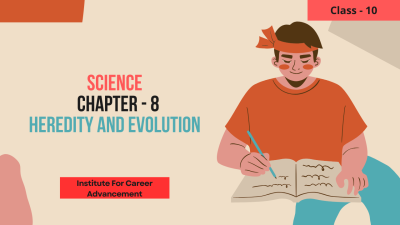Course description
Unravel the mysteries of life in Class 10 with Heredity and Evolution! This course delves into two fascinating concepts that explain the incredible diversity of life on Earth. Get ready to explore how traits are passed down from generation to generation (heredity) and how living things change over time (evolution).
The Legacy of Life:
Heredity Unveiled: Heredity refers to the transmission of traits from parents to offspring. Discover how characteristics like eye color, height, or disease resistance are passed on, creating similarities between generations.
The Laws of Inheritance: Explore the pioneering work of Gregor Mendel and his experiments that laid the foundation for our understanding of heredity. Learn about concepts like dominant and recessive genes and how they influence the inheritance of traits.
A World in Transformation:
Evolution: The Big Picture: Evolution explores how living things change and adapt over generations. This course will introduce you to the theory of evolution by natural selection, proposed by Charles Darwin.
Natural Selection as the Driving Force: Understand how variations in traits within a population can influence survival and reproduction. Individuals with beneficial traits are more likely to survive and pass those traits on, leading to gradual changes in the population over time.
Evidence for Evolution: Explore various lines of evidence that support the theory of evolution, including fossils, comparative anatomy, and embryology.
Unifying the Concepts:
Heredity and Evolution: Hand in Hand: Discover how heredity and evolution are interconnected. The variations in traits that heredity provides are the raw material for evolution to act upon. Natural selection can favor certain traits, leading to changes in the population over generations.
The Impact on Life: Appreciate how heredity and evolution play a crucial role in the diversity of life on Earth. From the vast array of species to the adaptations that allow organisms to thrive in different environments, these concepts explain the tapestry of life.
Beyond the Basics:
DNA: The Blueprint of Life (brief overview): Gain a basic understanding of DNA, the molecule that carries genetic information and plays a central role in heredity.
Speciation: Explore the concept of speciation, the formation of new species from an existing one.
The Human Story: Learn how the principles of heredity and evolution can be applied to understand human variation and adaptation.
Enhancing Your Skills:
Model Building: Practice building models to visualize processes like DNA structure or inheritance patterns.
Problem-Solving: Apply your knowledge to explain how heredity and evolution can influence real-world scenarios (e.g., antibiotic resistance in bacteria).
Scientific Communication: Develop your scientific communication skills by effectively explaining complex concepts related to heredity and evolution using appropriate terminology (genes, dominant/recessive traits, natural selection, adaptation).
বংশগত এবং বিবর্তনের মাধ্যমে দশম শ্রেণীতে জীবনের রহস্য উন্মোচন করুন! এই কোর্সটি দুটি আকর্ষণীয় ধারণা নিয়ে আলোচনা করে যা পৃথিবীতে জীবনের অবিশ্বাস্য বৈচিত্র্যকে ব্যাখ্যা করে। বৈশিষ্ট্যগুলি কীভাবে প্রজন্ম থেকে প্রজন্মান্তরে চলে যায় (বংশগত) এবং সময়ের সাথে সাথে কীভাবে জীবন্ত জিনিসগুলি পরিবর্তিত হয় তা অন্বেষণ করার জন্য প্রস্তুত হন (evolution).
জীবনের উত্তরাধিকারঃ
বংশগতির উন্মোচনঃ বংশগতির অর্থ হল বাবা-মা থেকে সন্তানদের মধ্যে বৈশিষ্ট্যের সংক্রমণ। চোখের রঙ, উচ্চতা বা রোগ প্রতিরোধের মতো বৈশিষ্ট্যগুলি কীভাবে চলে যায় তা আবিষ্কার করুন, যা প্রজন্মের মধ্যে মিল তৈরি করে।
উত্তরাধিকারের আইনঃ গ্রেগর মেন্ডেলের অগ্রগামী কাজ এবং তাঁর পরীক্ষাগুলি অন্বেষণ করুন যা আমাদের বংশগতির বোঝার ভিত্তি স্থাপন করেছিল। প্রভাবশালী এবং অপ্রতিরোধ্য জিনের মতো ধারণাগুলি এবং কীভাবে তারা বৈশিষ্ট্যের উত্তরাধিকারকে প্রভাবিত করে সে সম্পর্কে জানুন।
রূপান্তরের একটি বিশ্বঃ
বিবর্তনঃ বড় ছবিঃ বিবর্তন অনুসন্ধান করে যে কীভাবে জীবন্ত জিনিসগুলি প্রজন্মের পর প্রজন্ম ধরে পরিবর্তিত হয় এবং মানিয়ে নেয়। এই কোর্সটি আপনাকে চার্লস ডারউইন দ্বারা প্রস্তাবিত প্রাকৃতিক নির্বাচন দ্বারা বিবর্তন তত্ত্বের সাথে পরিচয় করিয়ে দেবে।
চালিকাশক্তি হিসেবে প্রাকৃতিক নির্বাচনঃ জনসংখ্যার মধ্যে বৈশিষ্ট্যের বৈচিত্র্য কীভাবে বেঁচে থাকা এবং প্রজননকে প্রভাবিত করতে পারে তা বুঝুন। উপকারী বৈশিষ্ট্যযুক্ত ব্যক্তিরা বেঁচে থাকার এবং সেই বৈশিষ্ট্যগুলি পাস করার সম্ভাবনা বেশি থাকে, যা সময়ের সাথে সাথে জনসংখ্যার ধীরে ধীরে পরিবর্তনের দিকে পরিচালিত করে।
বিবর্তনের প্রমাণঃ জীবাশ্ম, তুলনামূলক শারীরস্থান এবং ভ্রূণবিজ্ঞান সহ বিবর্তন তত্ত্বকে সমর্থন করে এমন বিভিন্ন প্রমাণ অন্বেষণ করুন।
ধারণাগুলির একত্রীকরণঃ
বংশগত এবং বিবর্তনঃ হাতে হাতেঃ বংশানুক্রমিকতা এবং বিবর্তন কীভাবে একে অপরের সঙ্গে যুক্ত তা আবিষ্কার করুন। বংশগত বৈশিষ্ট্যের বৈচিত্র্যগুলি বিবর্তনের জন্য কাঁচামাল। প্রাকৃতিক নির্বাচন নির্দিষ্ট বৈশিষ্ট্যগুলিকে সমর্থন করতে পারে, যা প্রজন্মের পর প্রজন্ম ধরে জনসংখ্যার পরিবর্তনের দিকে পরিচালিত করে।
জীবনের ওপর প্রভাবঃ পৃথিবীতে জীবনের বৈচিত্র্যে বংশগত এবং বিবর্তন কীভাবে গুরুত্বপূর্ণ ভূমিকা পালন করে তার প্রশংসা করুন। প্রজাতির বিশাল বিন্যাস থেকে শুরু করে অভিযোজন পর্যন্ত যা জীবকে বিভিন্ন পরিবেশে উন্নতি করতে দেয়, এই ধারণাগুলি জীবনের টেপেস্ট্রিকে ব্যাখ্যা করে।
মৌলিক বিষয়ের বাইরেঃ
ডিএনএঃ দ্য ব্লুপ্রিন্ট অফ লাইফ (সংক্ষিপ্ত বিবরণ) ডিএনএ সম্পর্কে একটি মৌলিক ধারণা অর্জন করুন, অণু যা জিনগত তথ্য বহন করে এবং বংশগতিতে কেন্দ্রীয় ভূমিকা পালন করে।
নির্দিষ্টকরণঃ নির্দিষ্টকরণের ধারণাটি অন্বেষণ করুন, বিদ্যমান একটি থেকে নতুন প্রজাতির গঠন।
মানুষের গল্পঃ মানুষের বৈচিত্র্য এবং অভিযোজন বোঝার জন্য বংশগত এবং বিবর্তনের নীতিগুলি কীভাবে প্রয়োগ করা যেতে পারে তা শিখুন।
আপনার দক্ষতা বৃদ্ধি করুনঃ
মডেল বিল্ডিংঃ ডিএনএ কাঠামো বা উত্তরাধিকার নিদর্শনগুলির মতো প্রক্রিয়াগুলি কল্পনা করার জন্য বিল্ডিং মডেলগুলি অনুশীলন করুন।
সমস্যা সমাধানঃ বংশগত এবং বিবর্তন কীভাবে বাস্তব-জগতের পরিস্থিতিগুলিকে প্রভাবিত করতে পারে তা ব্যাখ্যা করতে আপনার জ্ঞান প্রয়োগ করুন। (e.g., antibiotic resistance in bacteria).
বৈজ্ঞানিক যোগাযোগঃ উপযুক্ত পরিভাষা (জিন, প্রভাবশালী/অপ্রতিরোধ্য বৈশিষ্ট্য, প্রাকৃতিক নির্বাচন, অভিযোজন) ব্যবহার করে বংশগত এবং বিবর্তন সম্পর্কিত জটিল ধারণাগুলি কার্যকরভাবে ব্যাখ্যা করে আপনার বৈজ্ঞানিক যোগাযোগ দক্ষতার বিকাশ করুন।



















